Home | Category: Art and Architecture
THE SPHINX
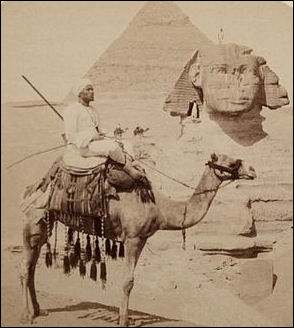 <br/> The Sphinx (near the Pyramids in Giza) is the famous colossal statue with the body of a lion and head of a Pharaoh-god. Situated in a pit on the Nile side of the Pyramids, it is 242 feet long and 66 feet high and is reached by walking through a temple made of massive rectangular blocks of stone. The Sphinx faces east towards the Nile and guards the entrance to the Pyramid complex. Although it is a massive statue it is dwarfed by the Pyramids and barely visible in front of them from a distance.
<br/> The Sphinx (near the Pyramids in Giza) is the famous colossal statue with the body of a lion and head of a Pharaoh-god. Situated in a pit on the Nile side of the Pyramids, it is 242 feet long and 66 feet high and is reached by walking through a temple made of massive rectangular blocks of stone. The Sphinx faces east towards the Nile and guards the entrance to the Pyramid complex. Although it is a massive statue it is dwarfed by the Pyramids and barely visible in front of them from a distance.
The face of the Sphinx is believed to be a likeness of Chephren, the builder of the second largest pyramid of Giza, and was intended to represent the pharaoh reborn as the sun god. There was once a false beard, a sign of virility, and a royal headdress with a cobra. In the 2000s it was discovered that there is a solar alignment between the sphinx and a temple built by Chephren (Khafre). When the setting winter solstice sun is observed from doorway of an 18th dynasty temple built a thousand years later than the Sphinx, it traces the outline of the head of the sphinx.
Some think the sphinx may be a modified yardang — an unusual, aerodynamically-stable rock formation that looks like an upside-down boat hull, with its prow end pointed into the wind. Sculpted smooth and streamlined by desert winds and sand carried by the winds, yardangs are up to tens of meters high and kilometers long. [Main Source: Mark Lehner, National Geographic , April 1991].
Categories with related articles in this website: Ancient Egyptian History (32 articles) factsanddetails.com; Ancient Egyptian Religion (24 articles) factsanddetails.com; Ancient Egyptian Life and Culture (36 articles) factsanddetails.com; Ancient Egyptian Government, Infrastructure and Economics (24 articles) factsanddetails.com
Websites on Ancient Egypt: UCLA Encyclopedia of Egyptology, escholarship.org ; Internet Ancient History Sourcebook: Egypt sourcebooks.fordham.edu ; Discovering Egypt discoveringegypt.com; BBC History: Egyptians bbc.co.uk/history/ancient/egyptians ; Ancient History Encyclopedia on Egypt ancient.eu/egypt; Digital Egypt for Universities. Scholarly treatment with broad coverage and cross references (internal and external). Artifacts used extensively to illustrate topics. ucl.ac.uk/museums-static/digitalegypt ; British Museum: Ancient Egypt ancientegypt.co.uk; Egypt’s Golden Empire pbs.org/empires/egypt; Metropolitan Museum of Art www.metmuseum.org ; Oriental Institute Ancient Egypt (Egypt and Sudan) Projects ; Egyptian Antiquities at the Louvre in Paris louvre.fr/en/departments/egyptian-antiquities; KMT: A Modern Journal of Ancient Egypt kmtjournal.com; Ancient Egypt Magazine ancientegyptmagazine.co.uk; Egypt Exploration Society ees.ac.uk ; Amarna Project amarnaproject.com; Egyptian Study Society, Denver egyptianstudysociety.com; The Ancient Egypt Site ancient-egypt.org; Abzu: Guide to Resources for the Study of the Ancient Near East etana.org; Egyptology Resources fitzmuseum.cam.ac.uk
History of the Sphinx
No one is sure who built the Sphinx. Unlike the Pyramids, there are no historical records of it being built. It can not even be dated properly. Based on estimates of rain wear in the cracks and wind erosion patterns, some scientists have concluded that the front and sides of the sphinx date to between 5000 and 7000 B.C., when the rainfall was heavier in the region. Scientists say that a “proto-sphinx” may have been carved at that time.
The Sphinx is generally believed to have originally been created around 2500 B.C. for Pharaoh Chephren and was an important part of his funerary complex. It is thought to have been carved from a limestone outcropping left behind in a U-shaped pit where stone was quarried for the pyramids. Chephren died before the Sphinx was completed and the monument was left unfinished. When Giza was abandoned the Sphinx was covered by sand.
About 1400 B.C., Egyptian prince Thutmose IV fell asleep under the Sphinx's chin and had a dream that someday he would free the statue from the sand. When he became Pharaoh he covered the Sphinx with limestone blocks, added the masonry forelegs and painted it yellow, blue and red. He placed a statue of his father — and a red granite stela with the story of his dream — on the Sphinx's chest. In the time of Thutmose IV the Sphinx was as ancient as Chatres cathedral is to us today. Ramses the Great later reworked the statue, added two more stelae and scratched in his name (and probably erased the name of Thumose's father).
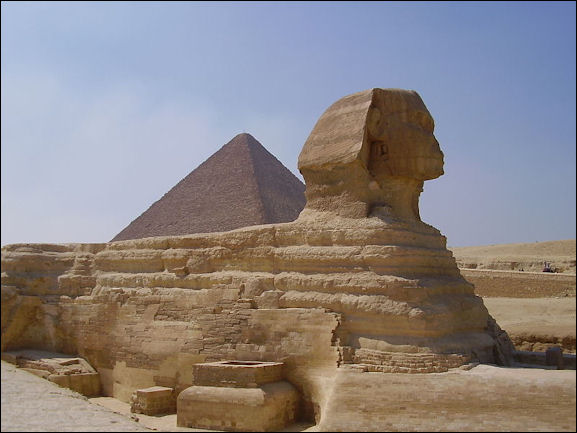
The Sphinx was known in Roman-Greco times. The riddle of the sphinx (What animal walks on all fours in the morning, two at noon and three at night? Answer: man as a crawling baby, upright adult and an old man with a cane) was an important plot devise in the Greek play “Oedipus Rex” . In Roman times, sand was cleared away from the Sphinx to make it presentable to Nero. Not long afterwards it was covered in sand again.
Arab historians in the 15th century reported that the Sphinx was already seriously disfigured. In 1818, an Italian sea captain found the Ramses stelae during an excavation (they are now in the Louvre). Parts of the beard were uncovered around the same time (they are now in the British Museum). The French cleared the sand away in the 1840s, which opened the monument up to the decaying process of wind and weather. The Sphinx wasn't completely cleared of sand until 1925.
The Sphinx's missing nose has been blamed on soldiers in Napoleon's army and the armies of the Turkish sultans, who shot it off for target practice. Mark Twain wrote in “Innocents Aborad” that a tourist in his party tried to hammer of a piece of the Sphinx's face for a souvenir. Napoleon’s army didn't do it. The nose was gone by the time the French general arrived in Egypt. It is generally believed that a 10th-century Islamist knocked the nose off the Sphinx for the same reason the large Buddhist statues in Afghanistan were destroyed in 2001: because the Sphinx violated the Muslim prohibition on religious images of humans and animals. Scientists are not sure who robbed the Sphinx of its nose but they know how it was done: Vandals hammered rods or chiseled into the top of the nose and its right nostril and pried the piece off.
The Sphinx has often been buried up to its neck. Records indicated that has been dug out at least three times: once in 1400 B.C. by Pharaoh Thutmose Iv; another time in the Roman era; and a third time in 1925 by the French egineer Emile Baraize.
Sphinx Alley in Luxor
The remains of hundreds of ancient sphinxes have been unearthed in Luxor and have recently been renovated and put on public display. Many were found on a road that had been identified as the ceremonial route "Sphinx Alley". The Sphinx Alley, also known as the Kabash path, connected the vast Karnak Temple in ancient Thebes to the Luxor Temple. Ancient Egyptians walked along the route once a year carrying the statues of the deities Amun, ancient Egypt's supreme god king, and Mut, a goddess worshipped as a mother, in a symbolic re-enactment of their marriage. [Source: Michael Theodoulou, The Australian, November 17, 2010]
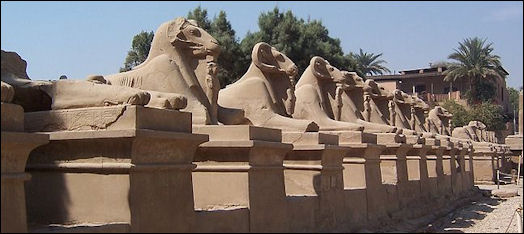
rams at Karnak temple
Michael Theodoulou wrote in the The Australian, “The road was later used by the Romans and is believed to have been renovated by Cleopatra, the fabled Ptolemaic queen, who left her name in hieroglyphics at the temple in Luxor.” "It maybe shows that Cleopatra brought Mark Antony or Caesar (on a journey up the Nile River) to visit Sphinx Alley," said Zahi Hawass, the renowned Egyptian archeologist. The Romans ruled Egypt after defeating Antony and Cleopatra.
The remains of 850 fragmented sphinxes have been discovered along a section of Sphinx Alley that was built by Pharaoh Amenhotep III, who ruled about 3400 years ago. They were erected on either side of the road, alongside chapels stocked with offerings for the deities. About 1350 sphinx statues are thought to have once flanked the path. Twelve discovered in 2010 — most missing their heads — were inscribed with the name of Nectanebo I, the founder of the last Pharaonic dynasty, who died in 362BC. They were found along an east-west road that adjoins the north-south Kabash path. Scholars knew of the road from ancient texts. The new finds were the first proof of its existence.
Obelisks in Ancient Egypt
 <br/> Obelisk de la Concorde A symbol of Egypt, second only to the pyramid, an obelisk is a four-sided pillar hewn from a single block of stone. Resembling the Washington Monument, they have highly polished surfaces carved with hieroglyphics and were originally capped with gold, copper or electrum, which shimmered in the sun light. "Obelisk" is a Greek word that means "meat skewer." Obelisks are believed to be advanced versions of pointed stones known as “ beneben” , which the Egyptians worshipped in prehistoric times as primordial mounds that arose from chaos. [Source: Evan Hadingham, Smithsonian]
<br/> Obelisk de la Concorde A symbol of Egypt, second only to the pyramid, an obelisk is a four-sided pillar hewn from a single block of stone. Resembling the Washington Monument, they have highly polished surfaces carved with hieroglyphics and were originally capped with gold, copper or electrum, which shimmered in the sun light. "Obelisk" is a Greek word that means "meat skewer." Obelisks are believed to be advanced versions of pointed stones known as “ beneben” , which the Egyptians worshipped in prehistoric times as primordial mounds that arose from chaos. [Source: Evan Hadingham, Smithsonian]
Obelisks were symbols of the pharaoh's power and served as fetishes honoring the sun-god Atum. They were often raised to mark important victories or the opening of a temple, or celebrated a coronation or other important event. Great care was taken making them, transporting them and raising them. Pliny the Elder wrote about kings names Ramses who roped his son to the top of an obelisk while it was being raised to drive home the point that special care was need to raise it.
Scores of obelisks were once found along the Nile. They were generally set up in pairs in front of temples; their inscriptions crowing the achievements of the pharaohs with lines like he will “exercise enduring kingship throughout eternity.”
Less than half a dozen obelisks remain in Egypt. There are more in Rome (13) than in all of Egypt. Others are scattered around Europe and North America. Some of them were taken by Romans. Others were sold off by modern Egyptians to pay off debts.
<br/>
Making Obelisks
 <br/> Unfinished Obelisk Most of the obelisks — and all the large ones — were hewn from the same granite quarry near the first cataract Aswan, where the delicate mottled pink granite, used to make statues, columns, bathtubs and sarcophagi, as well as obelisks, was found. Bronze and copper tools were too soft to chisel out the granite.
<br/> Unfinished Obelisk Most of the obelisks — and all the large ones — were hewn from the same granite quarry near the first cataract Aswan, where the delicate mottled pink granite, used to make statues, columns, bathtubs and sarcophagi, as well as obelisks, was found. Bronze and copper tools were too soft to chisel out the granite.
The obelisks were hammered in situ out of the stone. The quarry today is a collection of obelisk-shaped pits and shafts used to examine the quality of the rock. Much of what is known about obelisk making has been gleaned from the unfinished obelisk still in Aswan. Weighing over 1,000 tons it would have been the largest one ever made but cracked while being freed from the quarry bed. It was about 75 percent finished.
No chisel marks were found on the unfinished obelisk. It appears they removed by bashing channels in the rock with dolerite balls, weighing about eight pounds each. Dolerite is a stone that is harder than granite. Pits have been found with thousands of dolerite balls. The balls are believed to have been dropped repeatedly by rows of workers along the lines of the obelisk. The jobs was obviously arduous and cracking the rock was the biggest problem.
Transporting Obelisks in Ancient Egypt
Making obelisks was obviously a difficult task but what was even more remarkable was moving and raising them. From the 16th century to the 13th century B.C., the obelisks were maneuvered to the Nile on logs or some other rollers or pulled on a sled lubricated with olive oil, and loaded on barges and transported to their destinations. How they were raised remains a mystery.
A rare view of an obelisk being moved is found in the walls of the temple of Queen Hatshepsut (ruled 1498-1483B.C.). It shows two obelisks being loaded end to end on a barge towed by 27 boats. The obelisks may have been put in place by hauling them up a ramp and then sliding them down the other side untilhe bottoms rested on their pedestals and then pulling them upright using ropes and scaffolding. The only thing holding the obelisks in place on their pedestals is gravity. They were tough. One in Alexandria was toppled by an earthquake in 1301 but it didn’t break.
Famous Obelisks
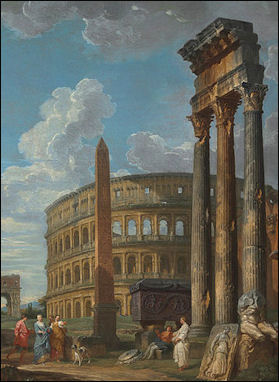 <br/> Obelisk in Rome Beginning with the Roman emperors Caligula and Nero, obelisks were greatly admired by world leaders and over the years they have been carted to many of the world's greatest cities, including Rome, Paris, Istanbul, and New York.
<br/> Obelisk in Rome Beginning with the Roman emperors Caligula and Nero, obelisks were greatly admired by world leaders and over the years they have been carted to many of the world's greatest cities, including Rome, Paris, Istanbul, and New York.
Obelisks are found in Central Park in New York, on the Thames embankment in London, and in Concorde Circle in Paris. The 220-ton, 69-foot-tall one in London was almost lost. The boat carrying it was hit by a storm and six men died after it was abandoned. The ship with obelisk was later found floating at sea. The obelisk was salvaged and sold to the British government for £2,000. The ones that ended up in New York were lowered using a special device — two iron saw horses with a pivit between them that clamped onto the obelisk’s center of gravity — developed by the engineers that built the Brooklyn Bridge. A wooden trestle was built to move it to its Central Park hilltop site.
Piazza San Giovanni in Laterno (Rome) contains the world's largest obelisk. Brought from Aswan, Egypt to Italy in A.D.357 by Emperor Constantius II and repositioned on the plaza in 1588, it was once 118 feet tall. Now it is 107½ feet tall and weighs 502 tons. The obelisk in St. Peter's Square was raised in 1586 with a 92-foot-high wooden tower outfit with pulleys by 900 men and 74 horses. The great obelisk at the Temple of Amun-Re at Karnak is nearly 100 feet high and weighs about 323 tons — about the same as a 747 jumbo jet.
The world's largest unfinished obelisk is in Aswan. Probably commissioned by Queen Hatshepsut in 1490 B.C., it is 137 feet tall and weighs 1,287 tons. It was rendered unusable by a crack, and still is sitting in the quarry where it was hewn.
Raising an Obelisk
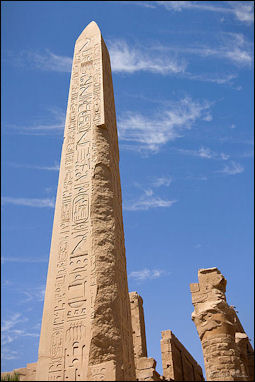 <br/> Obelisk in Luxor There are no historical records that show how the obelisks in ancient Egypt were raised. Possible methods include: 1) lowering the obelisk into a chamber filled with sand and removing the sand from below (this method was featured in Cecil B. DeMille's “Ten Commandments”); 2) placing the obelisk on a ramp and wedging it up and putting stones underneath it as it is raised. 3) dragging it up an incline and then easing it down to a pedestal with a hinge and pulling it upright.
<br/> Obelisk in Luxor There are no historical records that show how the obelisks in ancient Egypt were raised. Possible methods include: 1) lowering the obelisk into a chamber filled with sand and removing the sand from below (this method was featured in Cecil B. DeMille's “Ten Commandments”); 2) placing the obelisk on a ramp and wedging it up and putting stones underneath it as it is raised. 3) dragging it up an incline and then easing it down to a pedestal with a hinge and pulling it upright.
A team with 200 laborers, assembled by the NOVA public television series, attempted to raise a 43-foot-long, 40-ton granite obelisk without modern machinery. The team tested the sand method on a two-ton obelisk and found it didn't work very well because it was difficult to remove the sand evenly and maneuver the obelisk into place.
The NOVA team had the best luck with the hinge method. They slipped the obelisk down the ramp fairly easily so that it caught the hinge and slowly inched it upwards with levers and placed packing material underneath. The raised it to a 40-degree angle and found as the angle grew steeper, the supporting material became less stable. In the end the could not raise it with 200 men but felt that if they had 2,000 men they could do it.
Image Sources: Wikimedia Commons, The Louvre, The British Museum, The Egyptian Museum in Cairo
Text Sources: UCLA Encyclopedia of Egyptology, escholarship.org ; Internet Ancient History Sourcebook: Egypt sourcebooks.fordham.edu ; Tour Egypt, Minnesota State University, Mankato, ethanholman.com; Mark Millmore, discoveringegypt.com discoveringegypt.com; Metropolitan Museum of Art, National Geographic, Smithsonian magazine, New York Times, Washington Post, Los Angeles Times, Discover magazine, Times of London, Natural History magazine, Archaeology magazine, The New Yorker, BBC, Encyclopædia Britannica, Time, Newsweek, Wikipedia, Reuters, Associated Press, The Guardian, AFP, Lonely Planet Guides, “World Religions” edited by Geoffrey Parrinder (Facts on File Publications, New York); “History of Warfare” by John Keegan (Vintage Books); “History of Art” by H.W. Janson Prentice Hall, Englewood Cliffs, N.J.), Compton’s Encyclopedia and various books and other publications.
Last updated September 2018
